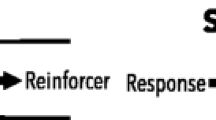Abstract
This article introduces hypnotic principles of confusion and trance as fundamental operations in Gestalt therapy. A process is identified which utilizes perceptual shifts of reference as a method of organizing Gestalt techniques. The sequence of operations constituting the confusion process is outlined and developed in a psychotherapy session through the use of implication, dissociation, and embodiment. The development of this organization of Gestalt therapy is intended to enhance the strategic capacities of therapists.
Similar content being viewed by others
References
Beahrs, J. O., & Humiston, K. E. Dynamics of experiential therapy.The American Journal of Clinical Hypnosis, 1974,17, 1, 1–14.
Conn, J. H. Hypnosynthesis.The American Journal of Clinical Hypnosis, 1971,13, 208–221.
Erickson, M. H., Rossi, E. L., Rossi, S. I.Hypnotic realities. New York: Irvington Publishers, 1976.
Erickson, M. H.The confusion technique in hypnosis.The American Journal of Clinical Hypnosis, 1964,VI, 183–207.
Levendula, D. Principles of Gestalt therapy in relation to hypnotherapy.The American Journal of Clinical Hypnosis, 1963,6, 22–26.
Levitsky, A. Combining Hypnosis With Gestalt Therapy. In E. W. L. Smith (Ed.),The growing edge of Gestalt therapy. New York: Brunner Mazel, 1976.
Peake, T., Van Noorde, R., Abbott, W. Psychotherapy as an altered state of awareness: A common element.Journal of Contemporary Psychotherapy, 1979,10, 98–104.
Perls, F., Hefferline, R. F., Goodman, P.Gestalt therapy. New York: Dell Publishing Company, 1951.
Polster, E. Sensory functioning in psychotherapy. In J. Fagan & I. L. Shepherd (Ed.),Gestalt therapy now. New York: Harper and Row, 1970.
Smith, E. W. L. Altered states of consciousness in Gestalt therapy.Journal of Contemporary Psychotherapy, 1975, 7, 35–40.
Smith, E. W. L. The impasse phenomenon: A Gestalt therapy experience involving an altered state of consciousness.The Gestalt Journal, 1978,1, 1, 88–93.
Smith, E. W. L. The roots of Gestalt therapy. In E. W. L. Smith (Ed.),The growing edge of Gestalt therapy. New York: Brunner/Mazel, 1976.
Author information
Authors and Affiliations
Rights and permissions
About this article
Cite this article
Wright, R.C. Trance and confusion in Gestalt therapy. J Contemp Psychother 13, 70–76 (1982). https://doi.org/10.1007/BF00946203
Issue Date:
DOI: https://doi.org/10.1007/BF00946203



